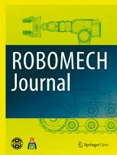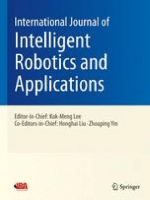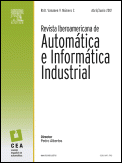
Industrial Robot-The International Journal of Robotics Research and Application
Scope & Guideline
Exploring Innovations in Automation and Robotics
Introduction
Aims and Scopes
- Robotic Control Systems:
Research focusing on control methods for various robotic systems, including adaptive control, impedance control, and disturbance rejection techniques. - Robotics in Manufacturing and Automation:
Studies on robotic applications in manufacturing processes, including welding, assembly, and material handling, highlighting innovations that enhance efficiency and quality. - Sensor Integration and Perception:
Exploration of sensor technologies and perception algorithms, such as SLAM (Simultaneous Localization and Mapping) and computer vision, for improving robot autonomy in dynamic environments. - Soft Robotics and Gripper Technologies:
Investigations into soft robotics, including the design and control of soft actuators and grippers aimed at enhancing dexterity and adaptability in handling tasks. - Human-Robot Collaboration:
Research on collaborative robots (cobots) that work alongside humans, emphasizing interaction strategies, safety, and ergonomic designs. - Robotic Applications in Agriculture and Environmental Monitoring:
Application of robotics in agricultural practices, addressing labor shortages and environmental challenges, focusing on automation in tasks like harvesting and monitoring. - Robotics in Healthcare and Rehabilitation:
Innovations in robotic systems for medical applications, including robotic surgery, rehabilitation devices, and assistive technologies.
Trending and Emerging
- AI and Machine Learning in Robotics:
The integration of AI and machine learning techniques in robotics is emerging as a significant trend, enhancing robot capabilities in perception, decision-making, and learning from interactions. - Robotic Systems for Industry 4.0:
Research focusing on the role of robotics in Industry 4.0, including smart manufacturing, predictive maintenance, and data-driven automation, is gaining traction. - Advanced Manipulation Techniques:
There is a growing interest in advanced manipulation techniques, such as hybrid control strategies and learning-based approaches for robotic arms and end-effectors. - Autonomous Navigation and Path Planning:
Emerging themes in autonomous navigation, particularly in dynamic and unstructured environments, are becoming more prevalent, with a focus on real-time path planning and obstacle avoidance. - Soft Robotics and Biomimicry:
The field of soft robotics, inspired by biological systems, is on the rise, focusing on adaptable and flexible robot designs that can safely interact with their environment. - Teleoperation and Remote Robotics:
The development of teleoperation systems, especially in contexts like remote surgery and disaster response, is increasingly featured, reflecting the need for human oversight in robotic operations.
Declining or Waning
- Traditional Industrial Robotics:
The emphasis on traditional industrial robots performing repetitive tasks is waning as industries increasingly adopt collaborative robots and automation technologies that integrate advanced sensing and AI. - Basic Robotics Education and Theory:
Papers focusing solely on fundamental robotic theories without applications or advancements in technology are becoming less frequent, as the journal shifts towards more applied research. - Robotics in Entertainment:
Research related to robotics in entertainment, such as robotic toys and performance arts, has decreased, possibly due to the focus on more impactful applications in industries like healthcare and manufacturing. - Robotic Systems in Isolated Environments:
The exploration of robotic systems designed for isolated or extreme environments (e.g., space or deep-sea) appears to be declining, as more attention is given to practical applications in urban and industrial settings.
Similar Journals

Journal of Sensor and Actuator Networks
Leading the way in instrumentation research.Journal of Sensor and Actuator Networks is a premier open-access journal published by MDPI, dedicated to advancing the field of sensor and actuator technology since its inception in 2012. With a commitment to disseminating cutting-edge research, the journal offers a platform for articles that explore the latest innovations and applications in the realms of computer networks and communications, control and optimization, and instrumentation. It proudly holds a prestigious Q1 ranking in instrumentation and Q2 rankings in both computer networks and control and optimization as of 2023, emphasizing its significant impact within these domains. The journal is indexed in Scopus and is recognized for its high-quality contributions, with impressive rankings including 9th in control and optimization and 19th in instrumentation. Researchers, professionals, and students seeking to stay at the forefront of sensor and actuator technologies will find a wealth of insightful articles and studies within its pages. As an open-access journal, it ensures that knowledge is widely accessible, fostering collaboration and innovation across the global scientific community. For more information, the journal is based in Basel, Switzerland, situated at ST ALBAN-ANLAGE 66, CH-4052 BASEL, SWITZERLAND.

Robotics, published by MDPI in Switzerland, stands at the forefront of interdisciplinary research, focusing on the latest advancements in robotics, artificial intelligence, control systems, and mechanical engineering. As an Open Access journal since 2012, it aims to disseminate high-quality research and innovative findings to a global audience, promoting collaboration among researchers, professionals, and students alike. With a commendable impact reflected in its 2023 categorizations—including Q2 rankings in Artificial Intelligence and Control and Optimization, and a prestigious Q1 in Mechanical Engineering—the journal underscores its significance within the scientific community. Notably, it boasts impressive Scopus rankings, standing within the top 20% in Mathematics and Control and Optimization. Robotics is dedicated to advancing knowledge and practice in the robotics domain, providing readers with valuable insights into emerging trends and technologies that shape the future of the field.

Artificial Life and Robotics
Exploring the Frontiers of AI and BiochemistryArtificial Life and Robotics, published by Springer, is a prominent journal in the fields of Artificial Intelligence and Biochemistry, Genetics, and Molecular Biology, with an ISSN of 1433-5298 and E-ISSN of 1614-7456. Established in 2005, the journal has continually contributed to knowledge and innovation in these rapidly evolving disciplines and is recognized for its significant impact, as indicated by its quartile rankings in the 2023 category assessments. The journal is currently positioned in Q4 for Artificial Intelligence and Q3 for General Biochemistry, Genetics and Molecular Biology, with a notable ranking of 138/221 and 262/350 in respective research areas. While it currently does not follow an open access model, it remains a valuable resource for researchers, professionals, and students seeking to advance their understanding and application of artificial life and robotic technologies. With an emphasis on interdisciplinary research, this journal aims to bridge theoretical foundations with practical applications, making it an essential platform for cutting-edge studies and discussions in the field.

Frontiers in Robotics and AI
Leading the Charge in Robotics and Artificial Intelligence ExplorationFrontiers in Robotics and AI is a leading journal dedicated to the exploration and dissemination of groundbreaking research in the fields of robotics and artificial intelligence. Published by FRONTIERS MEDIA SA in Switzerland, it has established itself as a vital resource for academics, professionals, and students since its inception in 2014. With an impressive Open Access model, the journal ensures that high-quality research is accessible to a global audience, fostering collaboration and innovation. The journal is recognized for its distinguished impact in the academic community, achieving Q2 quartile rankings in both Artificial Intelligence and Computer Science Applications as of 2023. It currently holds a solid position in Scopus rankings, with a rank of #123 out of 350 in Artificial Intelligence and #223 out of 817 in Computer Science Applications, reflecting its robust contribution to these dynamic disciplines. The journal's scope encompasses a wide range of topics, including but not limited to autonomous systems, machine learning, and human-robot interaction, making it an essential platform for innovative ideas and advanced research.

INTERNATIONAL JOURNAL OF ROBOTICS & AUTOMATION
Pioneering Research in Robotics and Automation.International Journal of Robotics & Automation is a premier academic journal published by ACTA PRESS, dedicated to advancing knowledge and applications in the dynamic fields of robotics, automation, and related engineering disciplines. With a history spanning from 1995 to 2024, this journal serves as a crucial platform for the dissemination of innovative research, offering valuable insights across various categories, including Artificial Intelligence, Control and Systems Engineering, and Mechanical Engineering. Although currently not open access, its rigorous peer-reviewed articles hold significance for researchers, professionals, and students alike, providing a solid foundation for advancements in technology and engineering methodologies. The journal's rankings in Scopus reflect its growing impact, particularly in niche areas of Modeling and Simulation and Software, highlighting the critical need for cutting-edge research and discussion in these developing fields. As the landscape of robotics and automation continues to evolve, this journal remains an essential resource for those seeking to contribute to and engage with the forefront of scholarly research.

Journal of Field Robotics
Connecting Theory and Practice in RoboticsJournal of Field Robotics, published by WILEY, is an esteemed peer-reviewed journal focusing on the cutting-edge developments in the area of robotics applied to real-world environments. With an ISSN of 1556-4959 and an E-ISSN of 1556-4967, this journal serves as a vital platform for researchers and professionals keen on advancing the fields of Computer Science Applications and Control and Systems Engineering, where it has earned a prestigious Q1 ranking in both categories as of 2023. The journal, which converges in its studies from 2006 to 2024, showcases original research that enhances the understanding and implementation of robotic systems in various fields, thus promoting innovative solutions to complex challenges. Access to the journal is through subscription-based options, ensuring a rigorous selection of high-quality research articles, reviews, and technical notes that contribute significantly to the academic community. With a solid Scopus ranking—39th out of 817 in Computer Science Applications and 17th out of 321 in Control and Systems Engineering, both in the 95th and 94th percentiles respectively—Journal of Field Robotics is essential reading for anyone interested in the future of robotics technologies and their transformative impact.

ROBOMECH Journal
Transforming Ideas into Solutions in Robotics and Mechanical EngineeringROBOMECH Journal, published by SpringerNature, is a prominent open-access journal dedicated to the fields of robotics, mechanical engineering, and artificial intelligence. Established in 2014, the journal has quickly established itself as a vital platform for disseminating innovative research in control and optimization, instrumentation, and modeling and simulation, earning a commendable Q2 ranking in Mechanical Engineering and multiple Q3 rankings across other relevant fields in 2023. With a commitment to facilitating accessible knowledge sharing, ROBOMECH Journal promotes cutting-edge research that drives advancements in both theoretical frameworks and practical applications within the robotics community. Scholars, engineers, and professionals seeking to contribute to or stay informed about the latest developments in these dynamic fields will find the journal's rich array of articles invaluable. With its open-access model, all published research is freely available, ensuring wide dissemination and increased visibility for authors, thus fostering collaboration and innovation across disciplines.

International Journal of Intelligent Robotics and Applications
Transforming Ideas into Intelligent RoboticsInternational Journal of Intelligent Robotics and Applications, published by SPRINGER SINGAPORE PTE LTD, is a pivotal platform dedicated to advancing the field of robotics and artificial intelligence. With an ISSN of 2366-5971 and an E-ISSN of 2366-598X, this journal has established its presence since its inception in 2017, showcasing innovative research and applications up until 2024. The journal aims to foster interdisciplinary collaboration by publishing high-quality articles that cover a broad range of topics from foundational AI concepts to cutting-edge robotics technologies. It holds respectable rankings, positioned in the Q3 category of Artificial Intelligence and Q2 category of Computer Science Applications in the 2023 metrics, and is indexed in Scopus with notable rankings in both computer science disciplines. Although it follows a subscription model, the journal remains committed to facilitating access to groundbreaking research for its audience of researchers, professionals, and students, contributing to the ever-evolving landscape of intelligent robotics.

Annual Review of Control Robotics and Autonomous Systems
Fostering Collaboration for Cutting-Edge Robotics ResearchAnnual Review of Control Robotics and Autonomous Systems, published by ANNUAL REVIEWS, is a premier, peer-reviewed journal dedicated to advancing the field of control, robotics, and autonomous systems. With its E-ISSN of 2573-5144, the journal is recognized for its high-caliber contributions, evidenced by its Q1 ranking in key categories, including Artificial Intelligence, Control and Systems Engineering, and Human-Computer Interaction. Spanning converged years from 2018 to 2024, it serves as an essential resource for researchers, professionals, and students who seek to stay abreast of the latest developments and methodologies impacting these rapidly evolving fields. The journal does not currently offer Open Access options, which enables it to maintain stringent quality control while ensuring that every issue is packed with scholarly articles that meet the highest academic standards. With a focus on interdisciplinary approaches and cutting-edge technologies, the Annual Review of Control Robotics and Autonomous Systems is poised as a critical voice for scholarly discourse, fostering innovation and collaboration in tackling complex challenges of the modern world.

Revista Iberoamericana de Automatica e Informatica Industrial
Unlocking Knowledge in Automation and InformaticsRevista Iberoamericana de Automatica e Informatica Industrial (ISSN: 1697-7912, E-ISSN: 1697-7920) is a distinguished open-access journal published by UNIV POLITECNICA VALENCIA, EDITORIAL UPV, since its inception in 2007. Based in Valencia, Spain, the journal aims to foster the dissemination of high-quality research in the fields of automation and industrial informatics. With a commendable impact reflected in its 2023 Scopus rankings—Q2 in Computer Science (miscellaneous) and Q3 in Control and Systems Engineering—it serves as a pivotal platform for innovative contributions from both established researchers and emerging scholars. The journal is committed to accessibility, ensuring that all articles are freely available to a global audience, promoting collaborative advancement in technology and engineering. Its coverage spans from 2007 to 2024, making it a valuable resource for those engaged in cutting-edge research and applications in the interdisciplinary landscape of computer science and engineering.